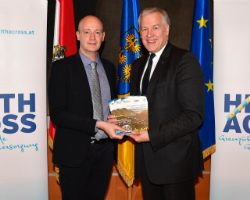Launch of new RHN publication on cross-border collaboration in health in Lower Austria

NLK Reinberger/Bianca Klaus
On 26 November 2018, in St. Pölten(Lower Austria region), the Regions for Health Network (RHN) launched a new publication entitled The Healthacross Initiative: how Lower Austria is boosting cross-border collaboration in health.
Access to quality and affordable preventive and treatment services is an important determinant of health and well-being. For those living and working in border areas, the nearest essential health services may be located in a neighbouring country.
The publication describes the experience of Lower Austria in the first large-scale effort to develop cross-border cooperation on health care between two neighbouring countries in the WHO European Region. It demonstrates an important trend in collaboration between countries on health governance.
In opening the press conference, Martin Eichtinger, Minister for Housing, Labour Market and International Relations, remarked: “A togetherness” of the Member States in the areas of economic affairs, employment, science and especially health care enhances the quality of life of citizens. Particularly in the field of health, cooperation across borders can make a difference. This is why we, in Lower Austria – in more than 12 years with our Healthacross Initiative – have put an emphasis on partnership and cooperation with our neighbouring regions.”
He concluded: “Our aim with the Healthacross Initiative is clear: to promote health in border regions. When it comes to health, we do not allow borders to narrow our thinking. My warmest thanks to the team of the Healthacross Initiative, led by Magister Elke Ledl. I am convinced, that this WHO publication will inspire other health regions in their cross-border work in the field of health.”
Francesco Zambon, Coordinator for Investment in Health and Development in Healthy Settings, reinforced the Minister’s words. “There is an important inequity issue involved when we speak about groups of people living near borders of regions compared to those who live far from borders. Even an ambulance called for an emergency can have problems in crossing borders between EU States. I am happy that this publication showcases bright solutions in the field of cross-border care, including accessibility to services that protect and promote population health.”
The publication highlights the following eight key messages on the implementation of cross-border health initiatives.
- Identify champions or mentors that can help early in the project: local political support is paramount to overcoming many obstacles.
- Choose strategic ways of working: plan entry points to cross-border health collaboration.
- Time is key: allot sufficient time to implement cross-border health collaboration.
- Involve stakeholders continuously and keep communication transparent.
- Actively scope out the local population’s needs before starting the project and seek its support and understanding.
- Ensure that cross-border collaboration in the field of health takes equity into consideration. This includes understanding the nature of barriers to accessing care and the importance of creating incentives to help reduce inequity in care in the area in question.
- Pilot-test strategically. Pilot tests are needed to preview the plan’s scalability and try out project activities.
- Ensure the sustainability of the initiative: establish a long-term vision of where it will be in 10–20 years and share it with the staff and other stakeholders.



